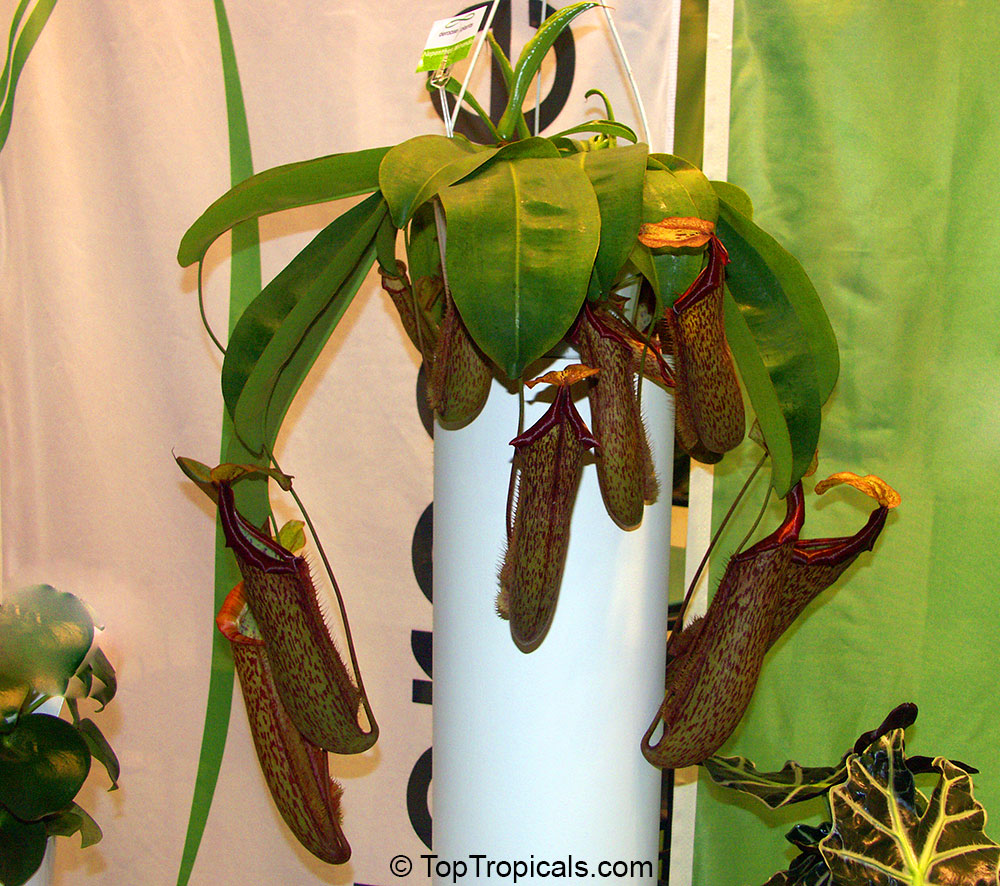Nepenthes: Deadly traps of Monkey Cups
by Alex Butova, the Witch of Herbs and Cats
Alexandra Butova is our columnist, journalist, and photographer, living in Riga, Latvia. She has has been with TopTropicals since Day One (2002), writing about magic plants, travel, and of course cats - from the CatNation she belongs to. Alex is in charge of TopTropicals.ru website.
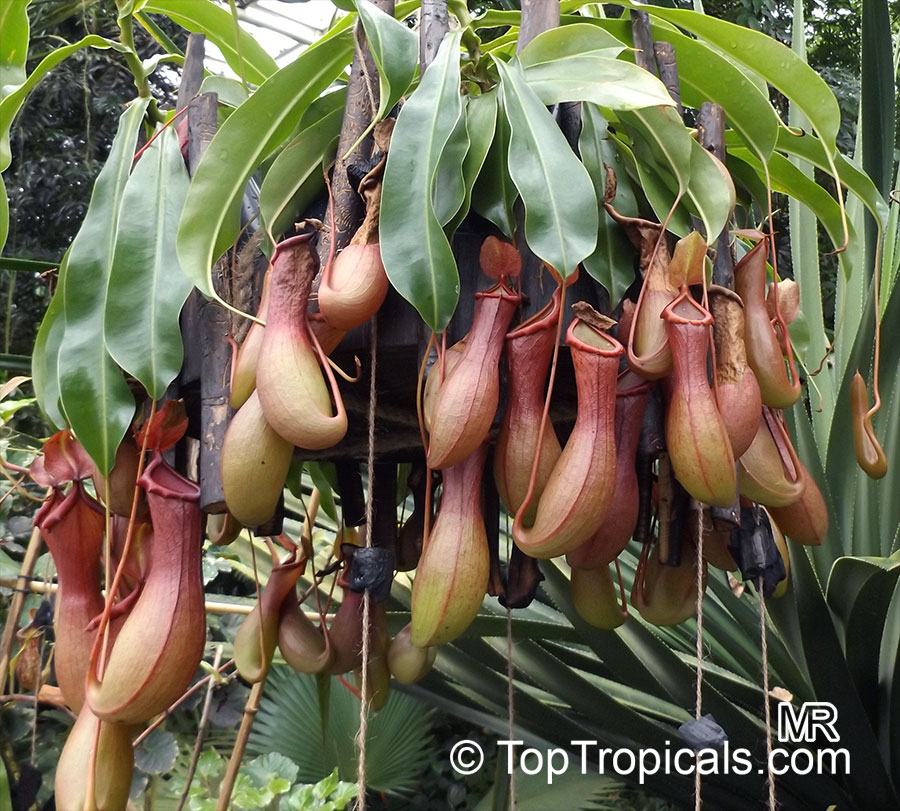
Nepenthes: Deadly Traps of Monkey Cups
...Prey usually consists ofinsects, but the largest Nepenthes species may occasionally catch smallvertebrates, such as rats and lizards.Records of cultivated plants trapping small birds have been made!..
Did you know that among plants, as well as among the animal world, you can find plants that feed on... meat! Or have you heard, but have never seen or imagine what they look like? Then this story is for you. Take a look and... and perhaps you will invite this unusual predator beauty into your home?..
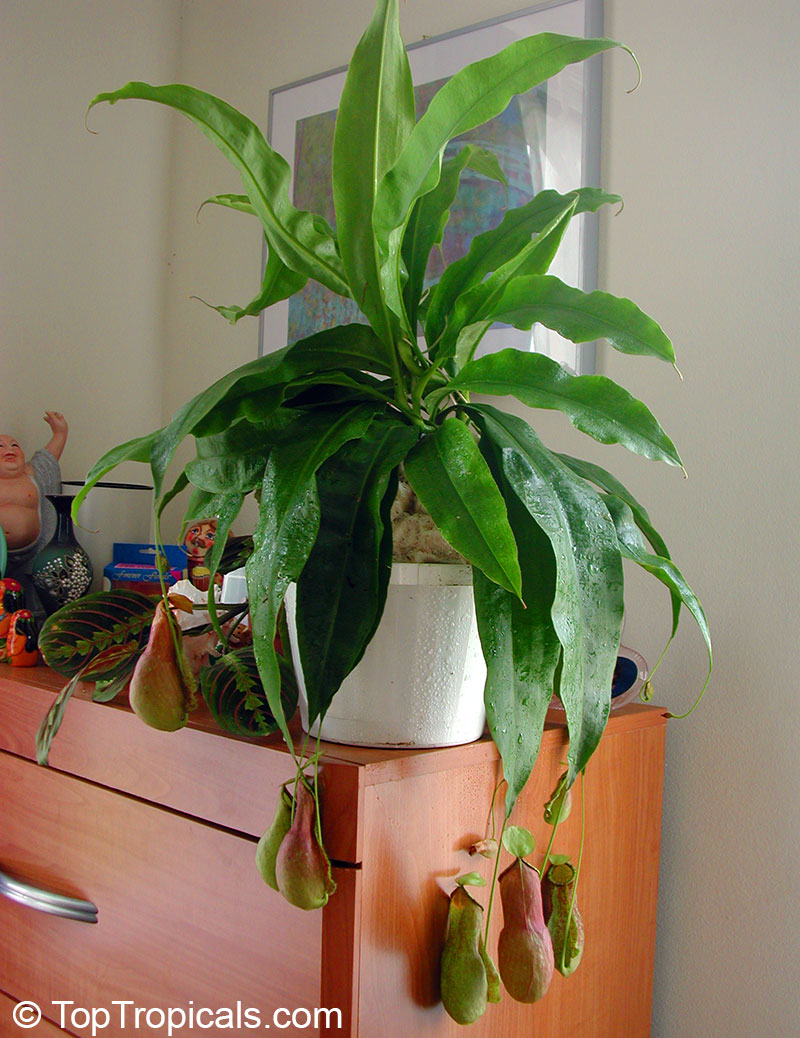
Carnivorous areplantsthat derive some or most of theirnutrientsfrom trapping and consuminganimalsorinsectsand otherarthropods. However, they still generate energy fromphotosynthesis. Carnivorous plants have adapted to grow in places where thesoilis thin or poor innutrients, especiallynitrogen, such as acidicbogs.
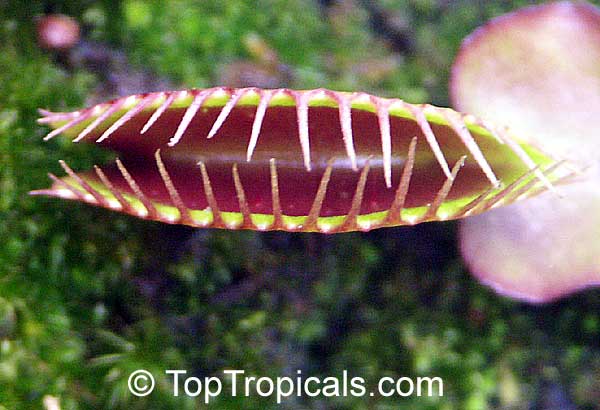
True carnivory is thought to haveevolved independentlynine times in five differentordersof flowering plants, and is represented by more than a dozengenera. Carnivorous plants can be found on all continents except Antarctica, as well as many Pacific islands.
Five basic trapping mechanisms are found in carnivorous plants:
- Pitfall traps (pitcher plants) trap prey in a rolled leaf that contains a pool ofdigestive enzymesorbacteria.
- Flypaper traps use a stickymucilage.
- Snap traps utiliserapid leaf movements.
- Bladder traps suck in prey with a bladder that generates an internalvacuum.
- Lobster-pot traps, also known as eel traps, use inward-pointinghairsto force prey to move towards a digestive organ.
These traps may be active or passive, depending on whether movement aids the capture of prey.
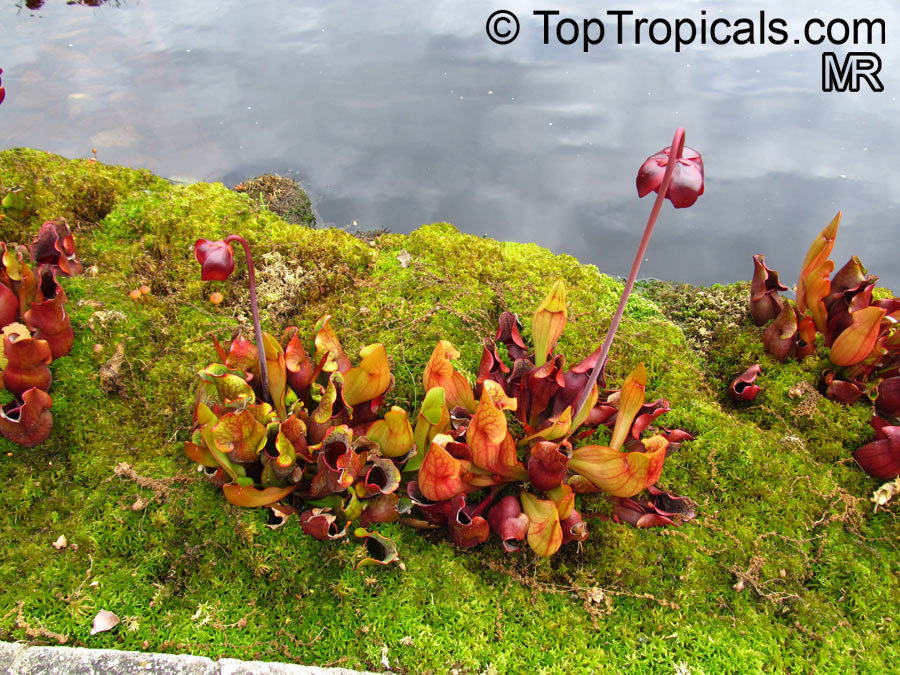
Sarracenia sp.
The term "pitcher plant" generally refers to members of the Nepenthaceae and Sarraceniaceae families - the most species-rich families of pitcher plants.
Nepenthesis agenusofcarnivorous plants, also known astropical pitcher plants, ormonkey cups, in themonotypicfamilyNepenthaceae. The genus comprises about170 species,and numerousnaturaland many cultivated hybrids. They are mostlyliana-forming plants of theOld Worldtropics, ranging from SouthChina,Indonesia,Malaysia, and thePhilippines; westward toMadagascarand theSeychelles; southward toAustraliaandNew Caledonia,and northward toIndiaandSri Lanka. Thegreatest diversityoccurs onBorneo,Sumatra, and the Philippines, with manyendemicspecies.
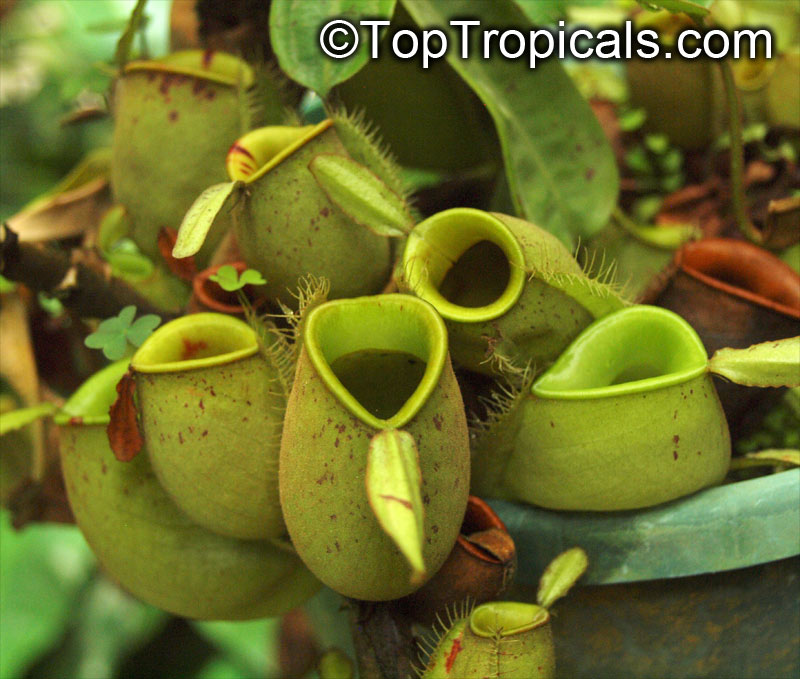
The name "monkey cups" refers to the fact thatmonkeyswere once thought to drink rainwater from the pitchers. This is false; monkeys do not drink from them, and the pitchers are filled with digestive juices, rather than rainwater.
The pitchers are borne at the end oftendrilsthat extend from themidribof an otherwise unexceptional leaf: Nepenthes are typically characterized as having reduced and symmetrical pitchers with a comprehensive waxy coating on the surface of the inner pitcher wall. The plants themselves are often climbers, accessing the canopy of their habitats using the aforementioned tendrils, although others are found on the ground in forest clearings, or asepiphyteson trees.
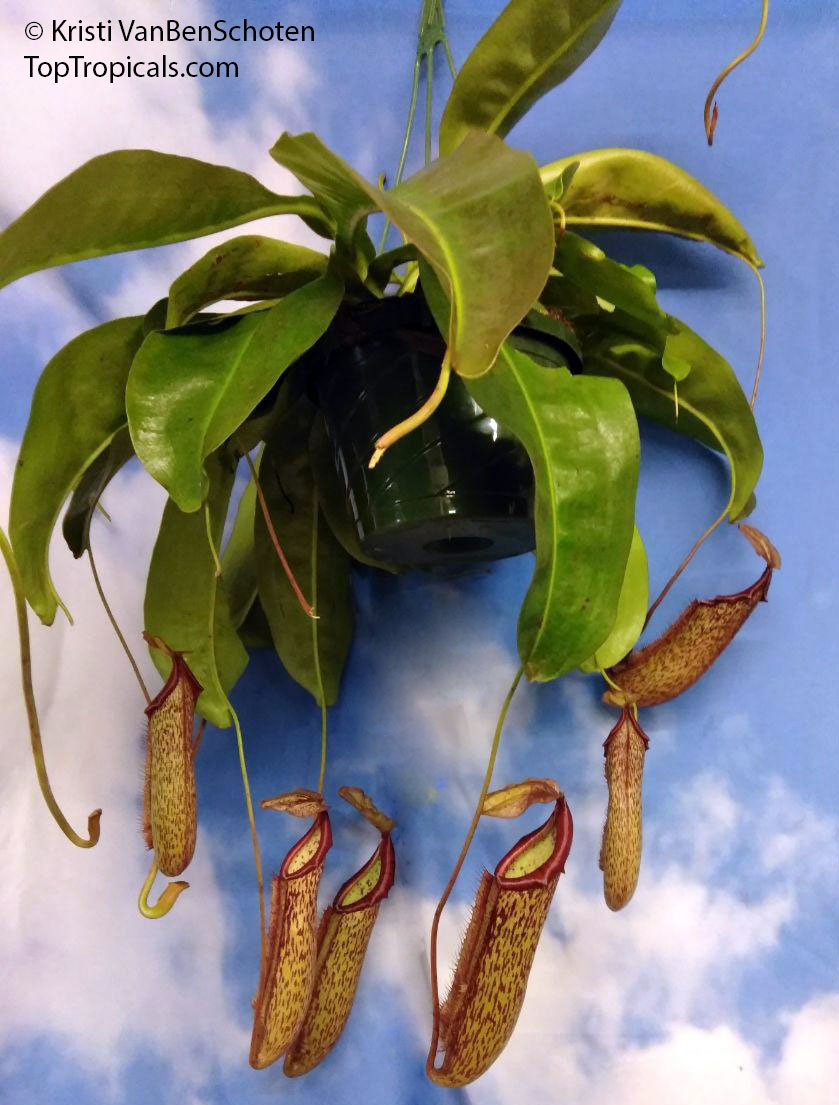
Nepenthesspecies usually consist of a shallow root system and climbing stem, often up to 50ft long and more. From the stems arise alternate, sword-shaped leaves with entireleaf margins. An extension of themidrib(thetendril), which in some species aids in climbing, protrudes from the tip of the leaf; at the end of the tendril the pitcher forms. The pitcher starts as a small bud and gradually expands to form a globe- or tube-shaped trap.The shapes can evoke a champagne flute.
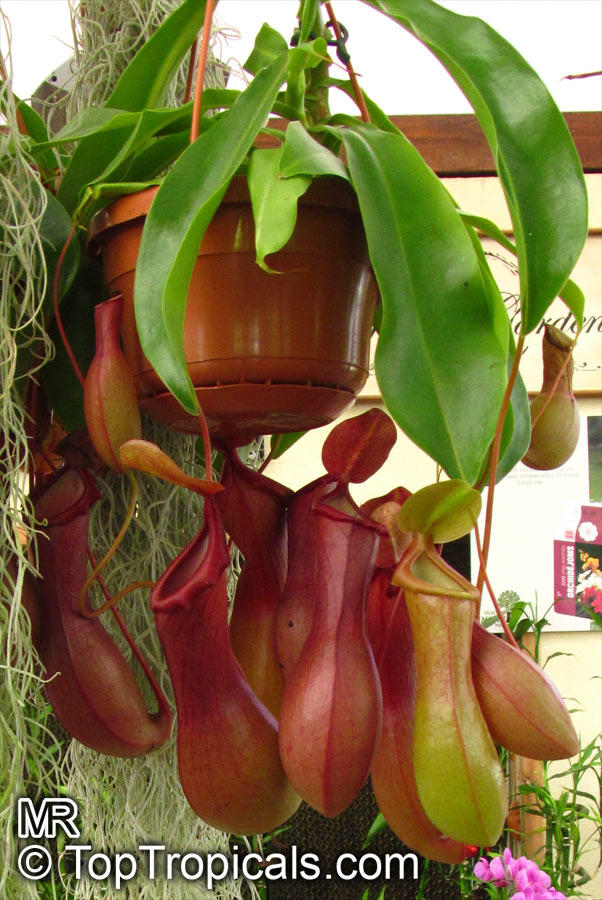
The trap contains a fluid of the plant's own production, which may be watery or more viscous, and is used to drown the prey. This fluid containsviscoelasticbiopolymersthat may be crucial to the retention of insects within the traps of many species. The trapping efficiency of this fluid remains high, even when significantly diluted by water, as inevitably happens in wet conditions.
The lower part of the trap contains glands which absorb nutrients from captured prey. Along the upper inside part of the trap is a slick, waxy coating which makes the escape of its prey nearly impossible. Surrounding the entrance to the trap is a structure called theperistome (the "lip"), which is slippery and often quite colorful, attracting prey, but offering an unsure footing.
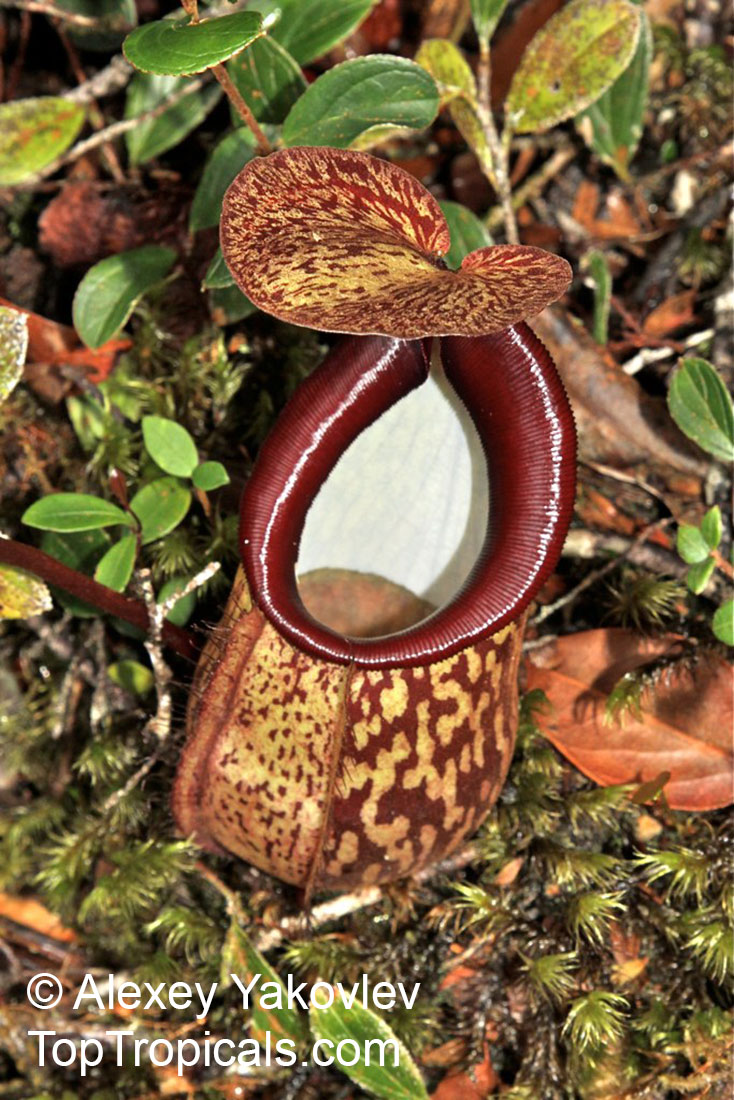
Nepenthes macfarlanei
Above the peristome is a lid (theoperculum); in many species, this keeps rain from diluting the fluid within the pitcher, the underside of which may containnectarglands which attract prey. Prey usually consists ofinsects, but the largest Nepenthes species may occasionally catch smallvertebrates, such as rats and lizards.Records of cultivated plants trapping small birds have been made!
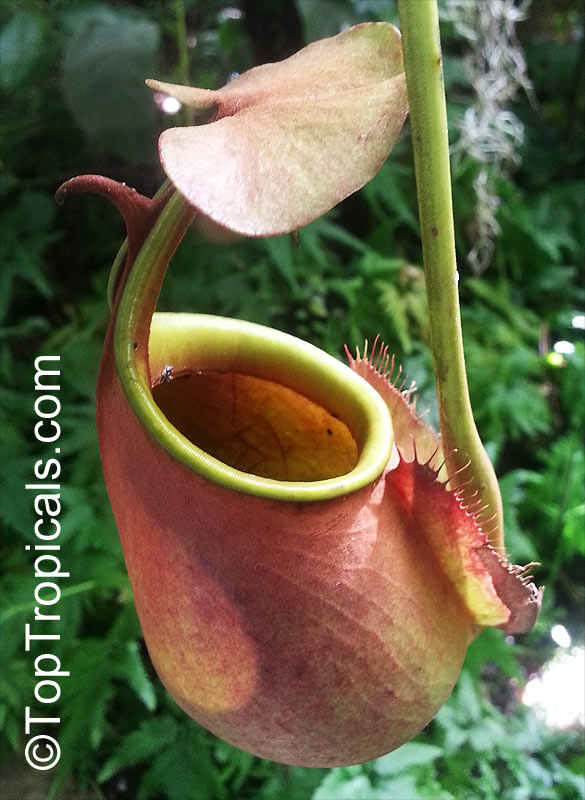
Nepenthes bicalcarata
Flowersoccur inracemesor more rarely inpanicleswithmaleandfemaleflowers on separate plants. They areinsect-pollinated, the primary agents being flies (includingblow flies,midges, andmosquitoes), moths, wasps, and butterflies. Their smells can range from sweet to musty orfungus-like.Seedis typically produced in a four-sided capsule which may contain 50–500 wind-distributed seeds.
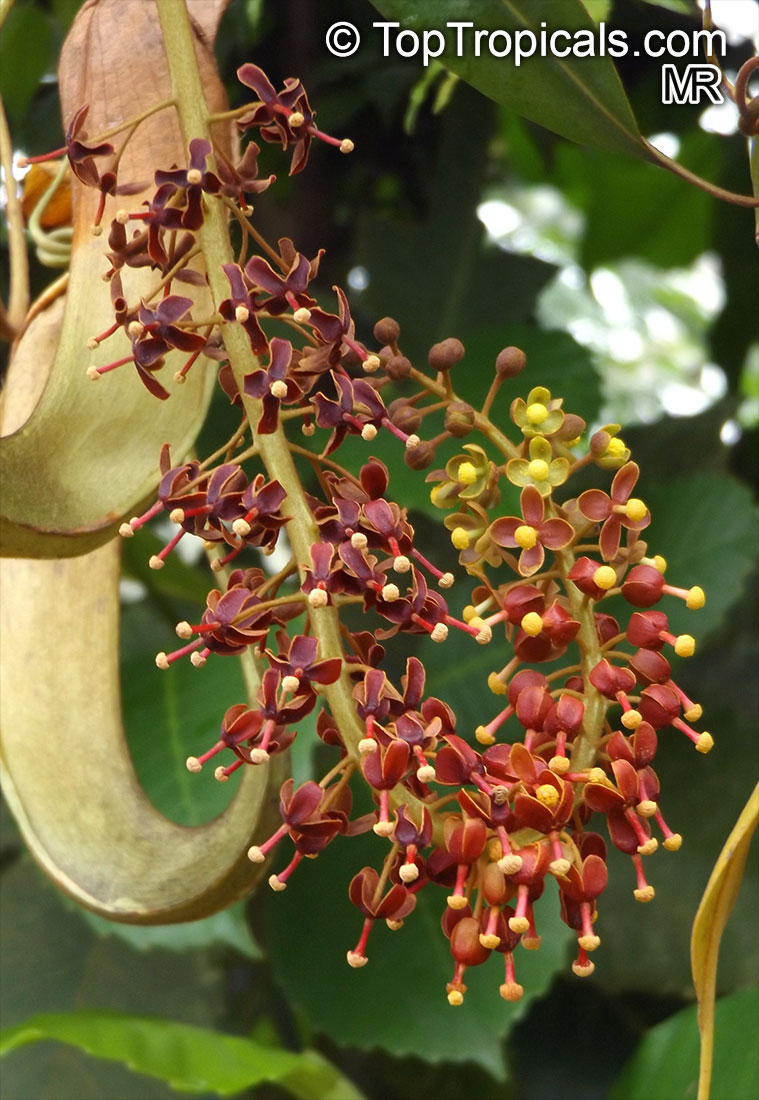
The most obvious interaction betweenNepenthesspecies and their environments, including other organisms, is that ofpredator and prey.Nepenthesspecies certainly attract and kill their prey, albeit passively, through active production of attractive colors, sugarynectar, and even sweet scents. From this relationship, the plants primarily gainnitrogenandphosphorusto supplement their nutrient requirements for growth, given these soil nutrients are typically lacking. The most frequent prey is an abundant and diverse group ofarthropods, withantsand otherinsectstopping the menu.
Nepentheshave also formed a dependent relationship with vertebrates and insects.So, for example, Nepenthesbicalcarataprovides space in the hollow tendrils of its upper pitchers for the carpenter ant to build nests. The ants take larger prey from the pitchers, which may benefitplant by reducing the amount ofputrefactionof collected organic matter that aid the plant's digestion.
The pitchers ofNepentheslowiiprovide a sugary exudate reward on the reflexed pitcher lid (operculum) and a perch forTreeshrew(Tupaia montana), which have been found eating the exudate and defecating into the pitcher. A 2009 study, which coined the term "Treeshrew lavatories", determined between 57 and 100% of the plant's foliar nitrogen uptake comes from thefaecesof Treeshrews.
Similarly,Nepentheshemsleyana, which is native toBorneo, has a symbiotic partnership withHardwicke's woolly bat. During the day, a bat may roost above the digestive fluid inside the pitcher. While a bat is inside, it may defaecate and the plant can get nitrogen from the droppings.
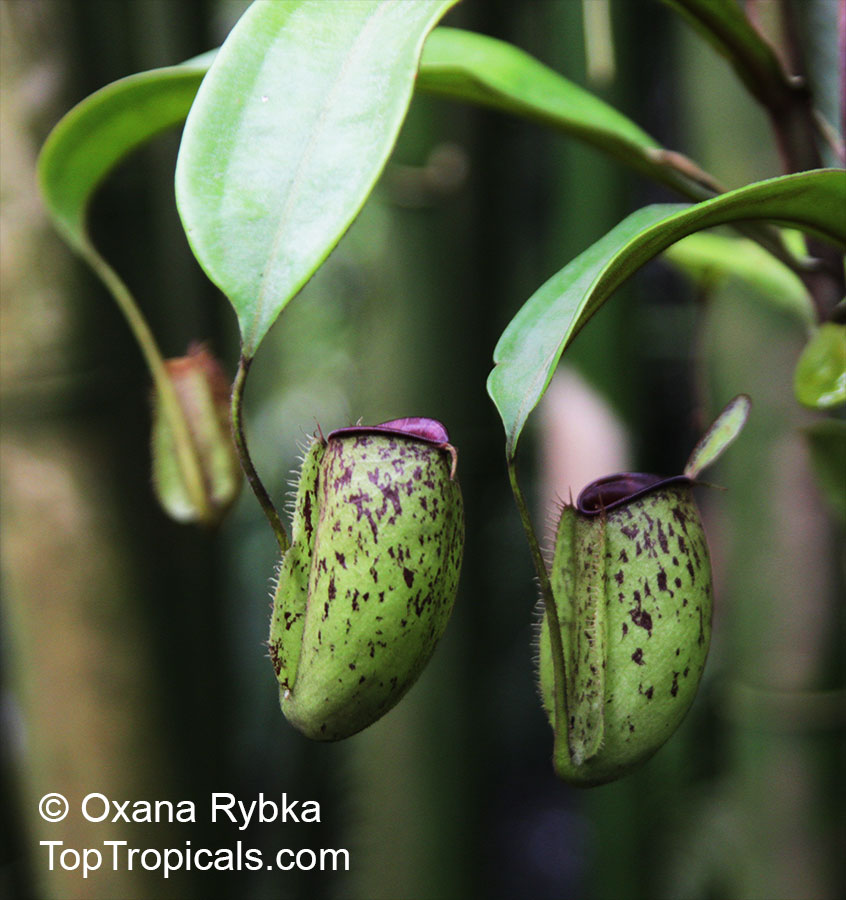
Nepenthesmay be cultivated in greenhouses. Easier species include Nepenthes alata, Nepenthes ventricosa,Nepentheskhasiana, Nepenthessanguinea, and Nepenthesalata is the most popular in home cultivation.
Nepenthesalata is extremely versatile and adaptable to many different growing conditions. Depending on where you live many of the needs of Nepenthes can be met by adapting them to your growing environment. This plant does well in both cooler or warmer conditions. Grow this fascinating pitcher plant in your home and it’s bound to draw some interest. This intriguing carnivorous plant not only makes an attractive and interesting feature in your home but it doubles up as a fly catcher too!
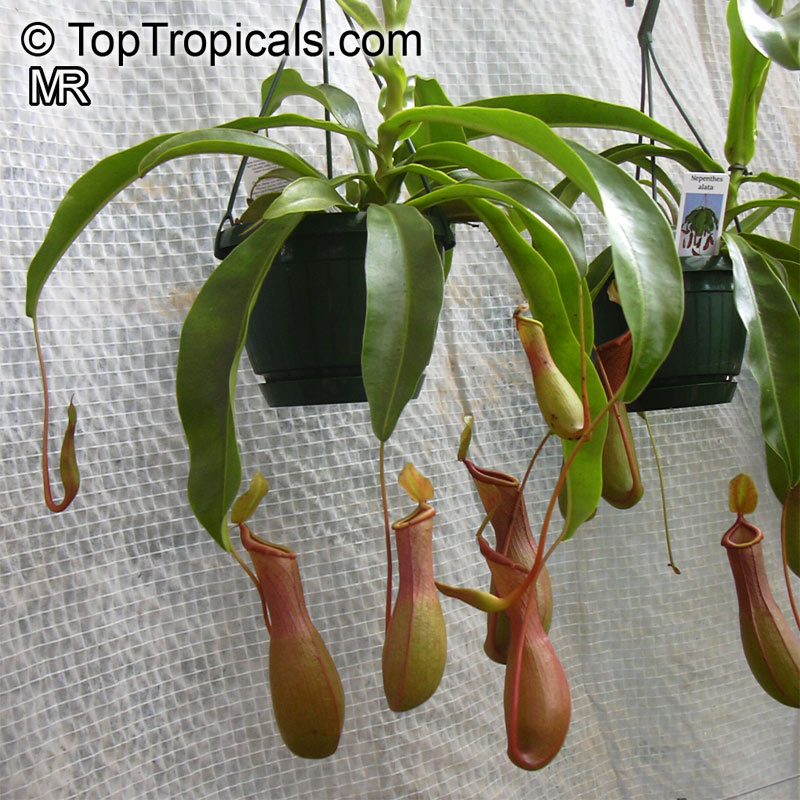
Nepenthes alata
The plants are upright but have large pitcher flowers which hang down on thread-like stems. A great choice for an indoor hanging basket or pot, the pinkish coloring of the flowers provides a splash of color beneath the green leaves. It is one of the easier Nepenthes types to grow, not requiring particularly difficult conditions, you can enjoy this plant in your kitchen, bathroom or any sunny windowsill.
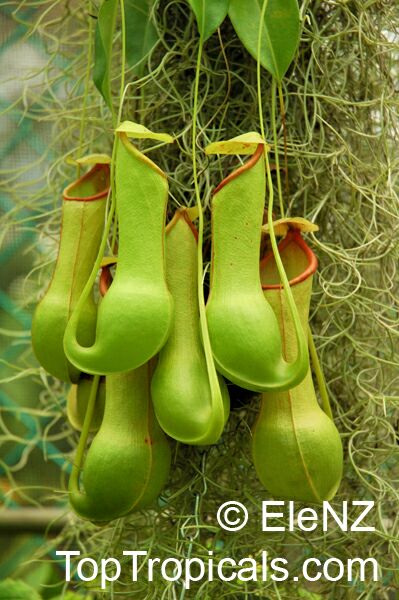
Nepenthes alata 'Boschiana'
The cultivar Nepenthes khsiana x ventricosa x maxima is a compact, easy-to-grow hybrid. It is a vigorous growing carnivorous tropical pitcher plant with large upright pitchers with cherry red speckles on yellow-green backgrounds. The trap mouths are wide and oval. Its parent species are quite adaptable, growing in the open or shade, among grasses and shrubs. It is very cold tolerant, but prefers warm, humid, bright conditions. It is quite good at catching large insects, such as: stink bugs, wasps and yellow jackets. It is a great house plant, that can be grown outdoors in the warm weather with a minimal transition period.
Nepenthesalata and Nepenthes x khsiana are good Nepenthes for beginners – invite them in your home!
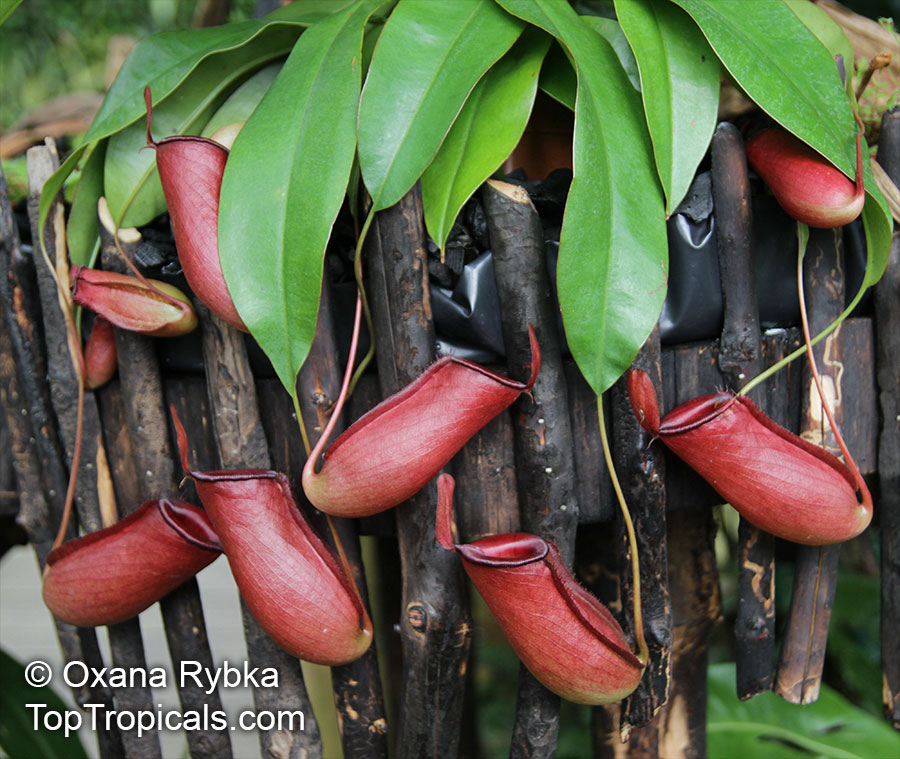
And some advice at last. After situating the plant where it is to grow, add a little water to the pitchers, about 1/2- 3/4 inch. In shipping or transporting, the fluid normally present gets dumped out and sometimes these pitchers will dry out and die. Refilling helps combat this. Pitchers and leaves die naturally as the plant grows and these should be trimmed off for best culture. Since many Nepenthes are vines, we suggest pruning the green stems back to encourage side shoots and a fuller plant.
The vines can also be trained up a stake or left to hang low in an elevated container such as a hanging basket. Allowing the vines to descend often encourages the plant to put up new basal shoots, resulting in a prettier plant. It is best not to prune more than 30% of the foliage off the plant at any one time. If the plant fails to make pitchers, increase humidity. Be careful: avoid dripping cold water on the leaves and don't mist them as it can encourage leaf spotting or diseases.
Do not fertilize these plants with dry fertilizer! They get all their food from "eating" insects! If you are growing the plant where it cannot catch insects for long periods, you can add an occasional small insect such as a fly, a cockroach or a few very small insects to mature pitchers. This is not normally needed. Many types benefit from very mild, diluted liquid orchid fertilizer such as SUNSHINE Orchidasm, and solution should be addedonly to the pitcherswhen they are 3/4 filled with water.
See more articles by Alex Butova

